#35mm restoration
Explore tagged Tumblr posts
Text
I've been scanning and restoring some pieces of original Star Trek: TOS film and wanted to share this before and after from a deleted scene in the episode "Elaan of Troyius":

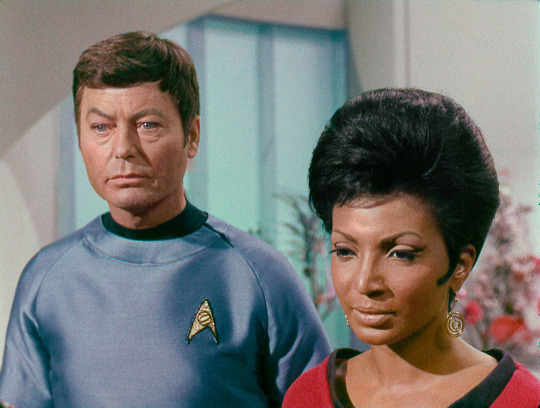
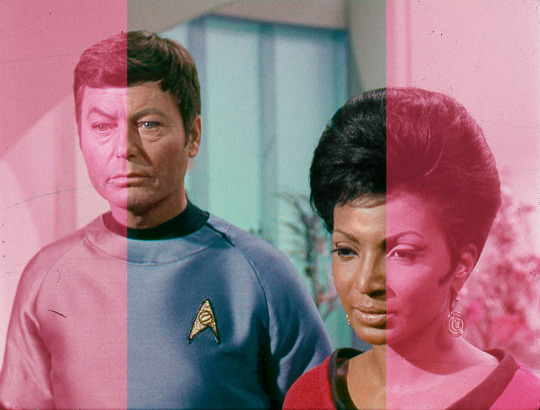

At nearly 60 years old, the film is in bad shape, exhibiting substantial scratches and color shifting. The magenta/red tint is a good example of dye fading, a sign of deterioration likely due to the film stock it was shot on.
Prior to 1950, color motion picture film was shot in Technicolor, which required a large, cumbersome camera to simultaneously expose 3 separate strips of negative film that then underwent a proprietary dye imbibition process to create a full color image. Though visually stunning and remarkably color-stable, it was a complicated, expensive process reserved only for high budget productions. In 1950, Eastman Kodak introduced Eastmancolor, the first 35 mm “single-strip” color motion picture negative -- in short, a film that was easy to shoot and process, and compared to Technicolor, only used a 1/3 of the film stock. Suddenly color film was an affordable option for studios and its popularity took off. Eastmancolor was composed of a single strip of negative film surfaced with 3 layers of light-sensitive gelatin emulsion. During development, a chemical reaction produced magenta, yellow, and cyan dyes on their corresponding layers, which were superimposed to create a full color image. Unfortunately, these dyes were unstable, something that wasn't apparent until aging films began to lose their color in the following years.
The Star Trek image above is pink because its yellow and cyan dyes have faded away, leaving just the magenta layer. The information may be lost, but digital restoration can improve what's left. But because the yellow and cyan greatly contributed to the overall density of the image, basic color balancing still produces a lower contrast version compared to what the original must have looked like. The missing richness and depth seems most apparent in the skin tones, but hand painting some of the color can bring a little life back to it, as I've done here. It's a challenge because, as far as I can tell, the only remaining footage or still shots of this scene show some level of dye fading. Fortunately, now that the film is digitized, restoration can be an ongoing project. If you own any color motion picture film negatives or prints, the sooner you get them scanned the better. In the meantime, helpful storage information can be found here.
It's been a while since I've shot any film (film major), so it's nice to see it again, even if it's chopped up into single frames. I have a small collection of them so I'll post more restored images as they're completed. BTW @cheer-deforest-kelley has a great post on how this film went from the editing room floor to the hands of fans.
#star trek#star trek the original series#tos#leonard mccoy#deforest kelley#nyota uhura#nichelle nichols#elaan of troyius#film preservation#film restoration#35mm film
2K notes
·
View notes
Text
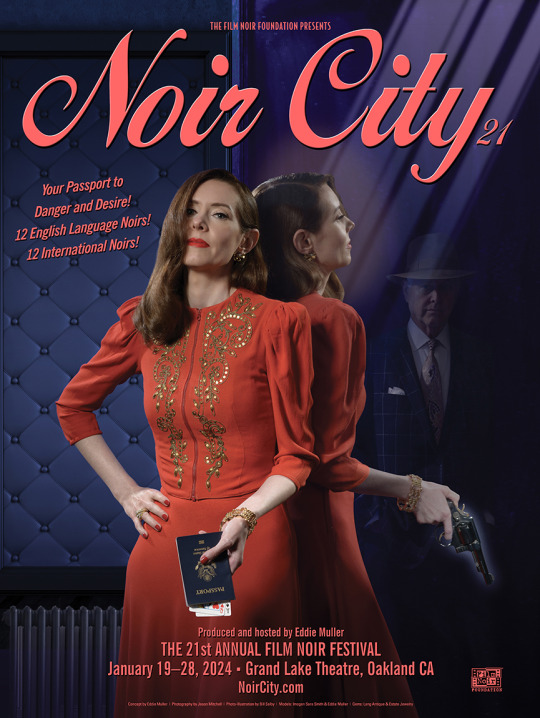
NOIR CITY 21
Celebrating its 21st year, NOIR CITY, the largest annual film noir festival in the world, returns to Oakland's Grand Lake Theatre, January 19-28, 2024. FNF president Eddie Muller will present a dozen double bills pairing an English language noir with a similarly themed foreign language film—24 films over 10 days. Whatever the country of origin, there are heists, prison breaks, missing persons, cultural alienation, love triangles, and lots of plain old-fashioned murder.
Muller says this edition "has been tailored to satisfy those folks who love noir filled with the colorful vernacular slang so essential to American and British noir—as well as adventurous viewers intrigued by seeing a familiar story—typically a crime committed for passion or profit—play out in cultures with different values, mores, and styles." Through his programming of NOIR CITY festivals around the nation and his hosting of the popular Noir Alley franchise on Turner Classic Movies, Muller aims to move audiences past the idea that film noir is a strictly American genre.
Joining him this year, as co-programmer and co-host, is acclaimed film scholar Imogen Sara Smith, a familiar commentator on The Criterion Channel streaming service. "Attending NOIR CITY in the Bay Area has been a highlight of my year for over a decade," says Smith, "and I'm thrilled to be joining Eddie as co-host this year. I'm especially excited that the program we've put together will introduce audiences to some rare international titles, alongside Hollywood classics. It's going to be a stellar festival."

Kicking off the collection of rarities is the FNF's most recent restoration — 1952's Argentine film Never Open That Door (No abras nunca esa puerta) — based on two short stories by American master of suspense fiction, Cornell Woolrich. The picture was preserved by the Film Noir Foundation in 2013 and has now been completely restored by the FNF through UCLA Film & Television Archive, thanks in part to a grant from the Golden Globe Foundation (formerly HFPA). Fernando Martín Peña, Argentina's pre-eminent cinephile, will be on hand to introduce the film with Eddie Muller.
Included on the 2024 schedule are English-language rarities such as Black Tuesday (1954), Plunder Road (1957), Across the Bridge (1957), and Strongroom (1962). Little-seen international titles include The Human Beast (France, 1938), Aimless Bullet (South Korea, 1960), Bitter Rice (Italy, 1949), Four Against the World (Mexico, 1950), Zero Focus (Japan, 1961), and Smog (1962), a forgotten surrealist masterpiece by Italian director Franco Rossi freshly restored by UCLA Film & Television Archive. Explore the full line up, buy tickets for individual double features and Passports (All-Access Passes) at the festival website.
GO TO NOIR CITY
#noir city#film noir foundation#eddie muller#film restoration#noir city 21#noir city oakland#grand lake theatre#imogen sara smith#Argentine film noir#35mm screening#film noir festival#never open that door#cornell woolrich#Martín Peña#tcm#noir alley#criterion channel#No abras nunca esa puerta
27 notes
·
View notes
Text
📸 Restore & Preserve Your Memories! 🎥
Do you have old, damaged photos or outdated media formats collecting dust? We offer Photo Restoration and Media Transfer Services to help you keep your memories alive for generations to come! From faded family photos to VHS tapes, we can restore and digitize your precious moments.
✨ Our services include:
• Photo Restoration
• VHS, DVD, and Film Transfers
• Digitizing Slides & Negatives
Check out how we can help preserve your memories today:
👉 https://www.pushingforwardproductions.com
Let us bring your past into the present! 💫
#pushingforwardproductions#artisticexpressions#artists on tumblr#graphic design#photography#creativejourney#digital art#disabled artist#photoretouching#photo restoration#media transfer#vhs tapes#8mm film#super 8mm#35mm film#film reel#USB
0 notes
Video
youtube
Scanning Bintang Ketjil 35mm Negative (1963) #filmrestoration
0 notes
Text

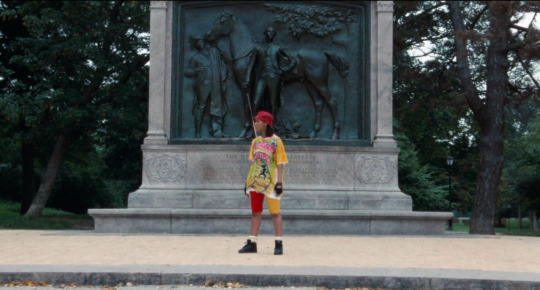


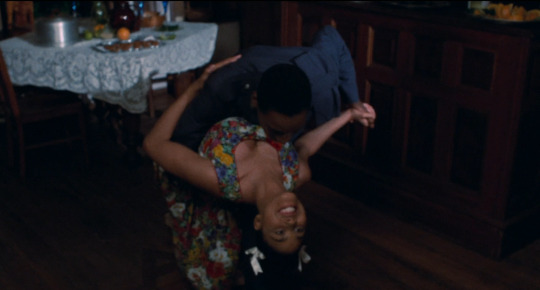

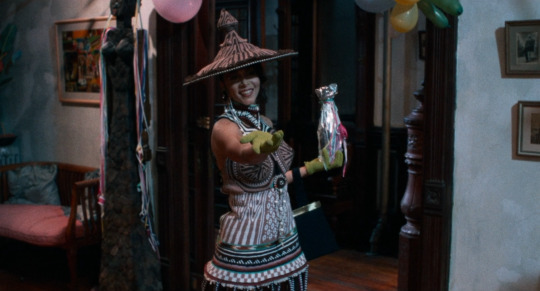

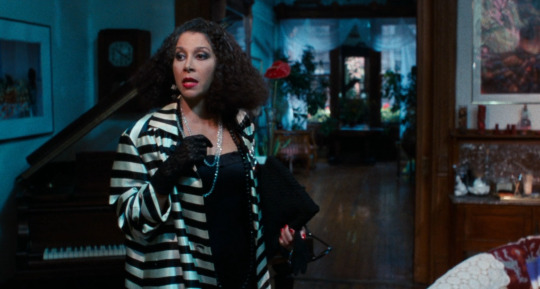
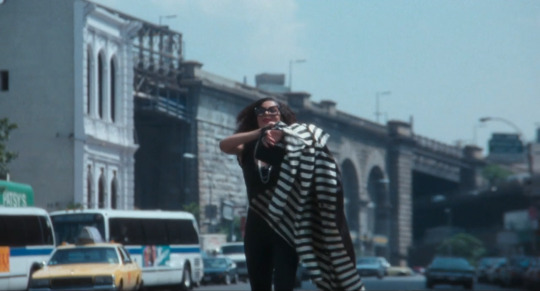

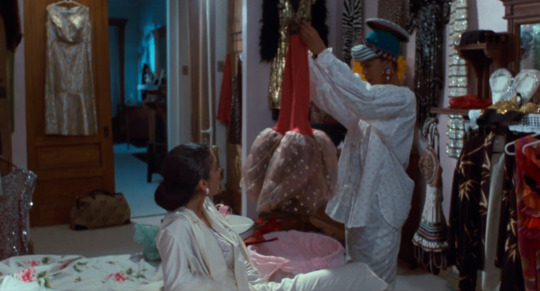
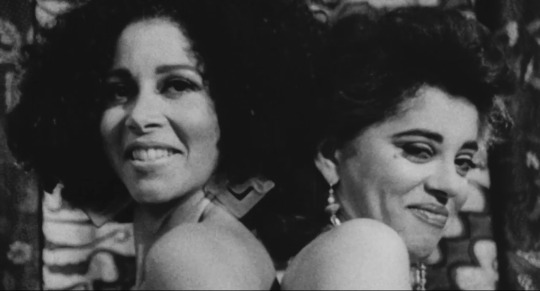
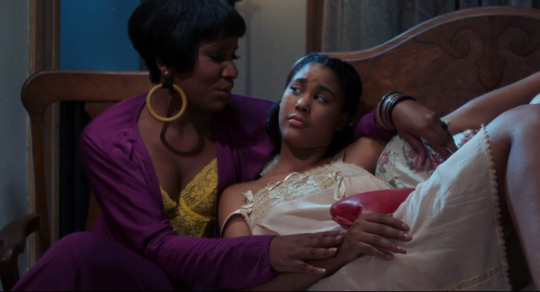


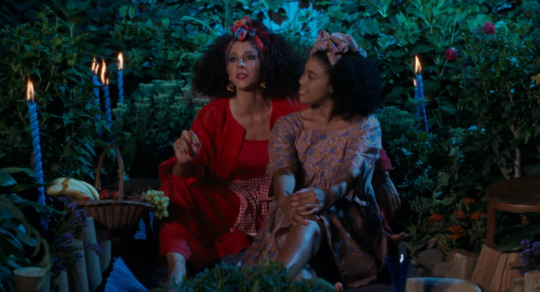
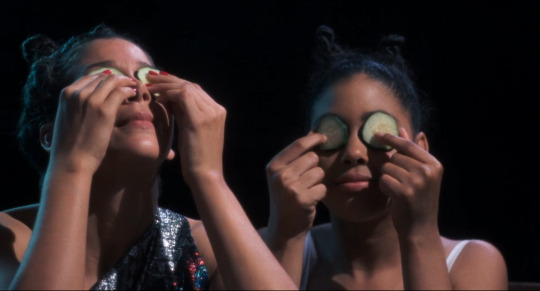
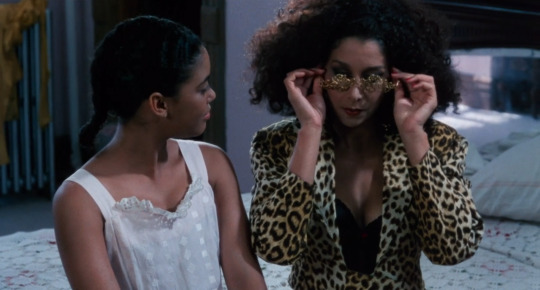
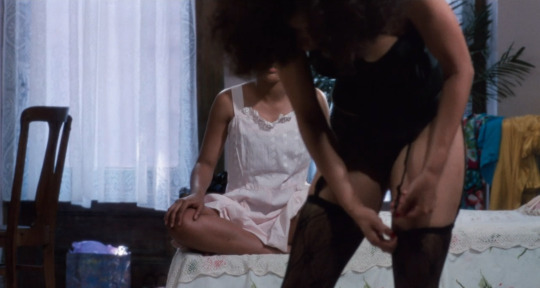

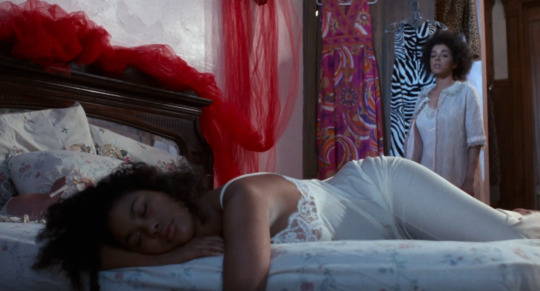
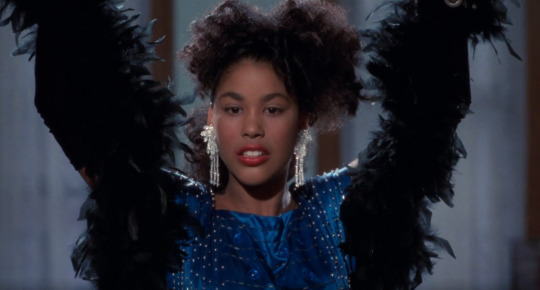


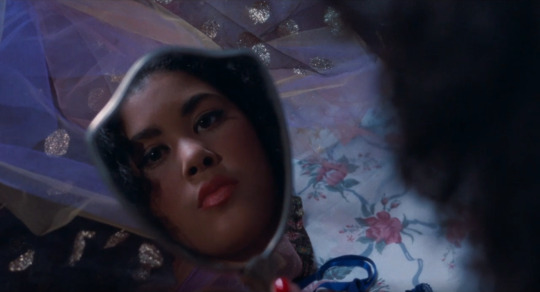
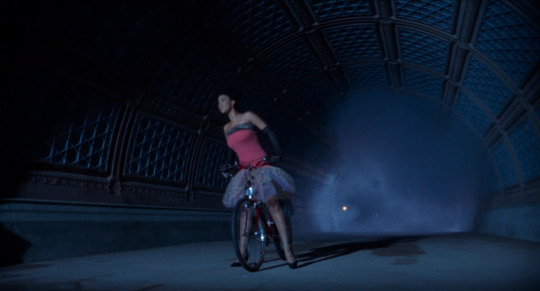

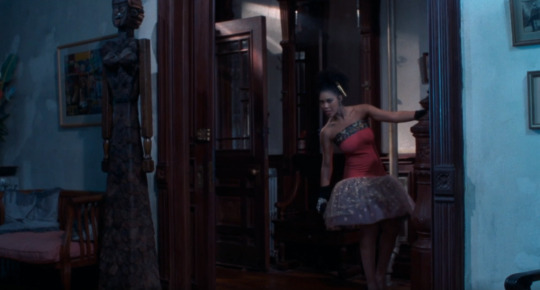
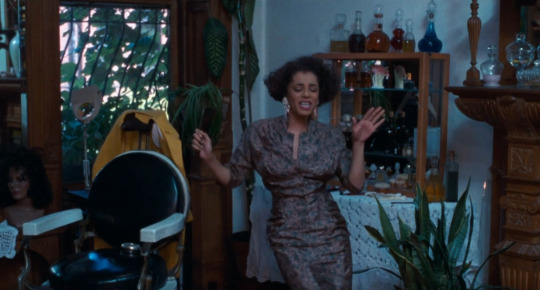
Alma's Rainbow (1994)
Ayoka Chenzira’s chic coming-of-age chef-d'œuvre, set in a beautiful townhouse in 90s Brooklyn, interrogates inter-generational relationships and black femininity; a total undersung masterpiece!
Director: Ayoka Chenzira
Cinematographer: Ronald K. Gray
Costume Designer: Sidney Kai Innis
Starring: Kim Weston-Moran, Victoria Gabrielle Platt, and Mizan Kirby.
#alma's rainbow#1994#female directed films#ayoka chenzira#90s films#black cinema#independent film#kim weston-moran#victoria gabrielle platt#mizan kirby#costume design#90s movies#90s aesthetic#cult classic#black films#black women#black history month#black filmmakers#female directors#woman director#black directors#35mm#brooklyn#90s black cinema#criterion channel#restoration
74 notes
·
View notes
Text

I was a skeptic about Criterion releasing any post-Showa Godzilla movies on disc, but lo and behold, they're teeing up Godzilla vs. Biollante, my favorite movie of all time, for 4K Ultra HD + Blu-ray (or just plain Blu-ray) on March 18. The description:
SPECIAL EDITION FEATURES:
New 4K digital restoration, with 5.0 surround DTS-HD Master Audio soundtrack
In the 4K UHD edition: One 4K UHD disc of the film and one Blu-ray with the film and special features
New audio commentary featuring film historian Samm Deighan, host of the podcast Eros + Massacreand coeditor of the book Revolution in 35mm
Making-of program from 1993 featuring director Kazuki Omori and special-effects director Koichi Kawakita, among others
Short documentary from 1993 about the Biollante and Super X2 vehicle concepts
Deleted special effects
TV spots and trailers
New English subtitle translation
PLUS: An essay by science-fiction and horror film expert Jim Cirronella
Yes, this means they're skipping over The Return of Godzilla and not waiting until all the Heisei films are in their hands to unload them as another box set. I was surprised at first, but it makes sense. Biollante is the only Heisei movie Toho has released on 4K in Japan so far (with The Return of Godzilla and Godzilla vs. Mechagodzilla II joining it in June), and arguably the best-regarded. Toho's always going to prioritize the domestic market first, so this is Criterion's best shot at a new release during Godzilla's current swell of popularity.
I have mixed feelings, as is usual when any new English kaiju/tokusatsu home release is announced. I'm glad the movie is back in physical circulation; it's again become legendary as the most difficult Godzilla movie to find on home video for a reasonable price. Only one library in my county owns it, and that number is about to spike. It'll be a major visual upgrade to boot. The non-G54 movies in the Criterion Showa box set didn't have audio commentaries, so I'm glad they sprung for one this time. I'm not familiar with Samm Deighan's work, but I think she's the first woman to record an English commentary for a Godzilla movie.
But...
I saw the Criterion presentation of Godzilla vs. Biollante at the Dryden Theater in October, and the subtitles were... simply not proofread, or at least not proofread by anyone who should have a job in the field. "More typos than a Mill Creek Ultraman Blu-ray" was how I described it at the time. I believe Criterion is using a number of vintage (we're talking probably-shown-in-Hawaii) subtitle scripts for the Toho tokusatsu films they're made available on streaming but not on disc, and I dearly hope they show more care with the Biollante 4K.
There's also no English dub.
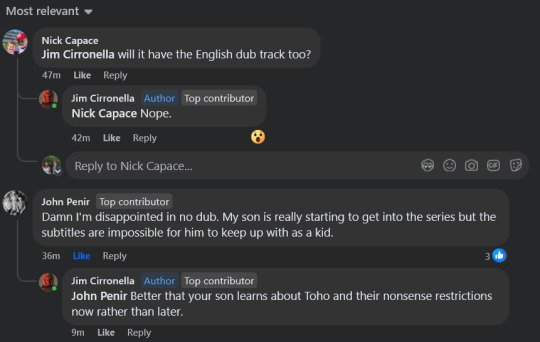
This suggests that Toho is now doing its best to bury all the pre-Reiwa Godzilla dubs, even the ones they commissioned themselves. I doubt Criterion will bother to include the film's English visuals either. So... the version of Biollante I rented from Blockbuster some 20 years ago, the version I grew up with, will just be completely erased from the latest-and-greatest (and last?) edition. Depressing stuff. The current incarnation of Toho might be embarrassed by those old dubs, but as an indignant woman in the Diet Building once exclaimed, the truth is the truth! And Biollante's one of the films I prefer to watch dubbed (for one, nobody can argue that the English the actors spoke on set was better than that recorded by the Hong Kong Players).
Lesser concerns: I'll have to double-check, but I think the making-of program and the short documentary were on the old Echo Bridge discs too. The trailers would be new, but, well, they're trailers. So potentially nothing fresh in the featurette department, certainly not a retrospective with surviving cast and crew. (Somebody get one of those done before we lose even more of them!) And I do feel bad for Ed Godziszewski, whose commentary for Echo Bridge was effectively pocket-vetoed by Toho and is now truly never going to see the light of day.
Bleh.
#i have a good deal of ambivalence about godzilla's current status as a pop culture colossus in general#but this post has gone on long enough#godzilla vs. biollante#godzilla#the criterion collection#home video
85 notes
·
View notes
Text

Howling II: Your Sister Is a Werewolf will be released on 4K Ultra HD + Blu-ray on October 29 via Vinegar Syndrome. Chris Barnes designed the cover art for the 1985 werewolf sequel; the original poster is on the reverse side.
Philippe Mora (Communion) directs from a script by The Howling novel series author Gary Brandner and Robert Sarno. Christopher Lee, Annie McEnroe, Reb Brown, Marsha Hunt, and Sybil Danning star.
The film has been newly restored in 4K from the 35mm original camera negative with Dolby Vision HDR. Special features are listed below.
Special features:
Commentary track with director Philippe Mora and author/screenwriter Kelly Goodner (new)
Commentary track with director Philippe Mora
Commentary track with composer Steve Parsons and editor Charles Bornstein
Lights, Camera, Werewolves? - a conversation with director Philippe Mora and filmmaker Michael Mohan (35 min)
A Romp Through Czechoslovakia - an interview with actress Annie Pressman (15 min)
Thrown to the Wolves - an interview with special make-up effects artist Steve Johnson (11 min)
A Life Collaboration with Philippe Mora - an interview with Pamela Krause, Philippe Mora's wife and artist consultant (11 min)
Freaky, Sexy, Mad - an interview with composer Stephen Parsons (16 min)
Lord of the Stricken Field - film historian Jonathan Rigby on Christopher Lee and Howling II (25 min)
Queen of the Werewolves - an archival interview with actress Sybil Danning (17 min)
Leading Man - an archival interview with actor Reb Brown (14 min)
A Monkey Phase - an archival featurette with special make-up effects artists Steve Johnson and Scott Wheeler (15 min)
Theatrical trailer
Still gallery
Ben is mourning the recent death of his sister, Karen, whom he believes to have been killed in a savage wolf attack. At her funeral, Ben is approached by the mysterious Stefan, who warns him that a cult of werewolves had attacked Karen and that she too will become an undead lycanthrope. Although dismissing his claim as mere superstition, Ben’s girlfriend Jenny convinces him that he should take Stefan’s warning more seriously, and, sure enough, Karen is soon back from the dead, covered in fur and complete with a deadly set of K9s. After being narrowly saved from a fatal bite by Stefan, Ben is persuaded that he’s telling the truth and volunteers to join him on his mission to destroy the increasing hoards of beastly creatures ravaging Europe. But as their journey takes them to Transylvania, where werewolves from around the world are gathering for their ritual, Ben and Stefan fear that they might be in over their heads, mainly once werewolf queen Stirba receives news of their arrival��
Pre-order Howling II: Your Sister Is a Werewolf.
#howling ii#the howling#christopher lee#sybil danning#vinegar syndrome#dvd#gift#horror#80s horror#1980s horror#philippe mora#annie mcenroe#reb brown#marsha hunt#Howling II: Your Sister Is a Werewolf
33 notes
·
View notes
Text
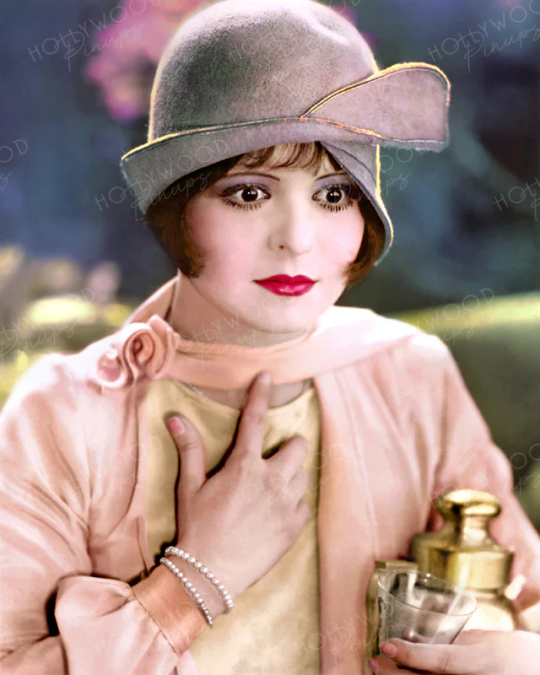
Century-Old Clara Bow Silent Film Believed Lost Forever Found
Long-Lost Clara Bow Silent Film Found in a Omaha Parking Lot.
The Pill Pounder, one of the key titles in the CV of the iconic flapper, has enjoyed a belated revival at the San Francisco Silent film festival
A century after she first began to turn heads, Clara Bow is “It” once more. The iconic flapper of the silent film era inspired Margot Robbie’s character Nellie in Damien Chazelle’s Hollywood epic Babylon, is namechecked on Taylor Swift’s forthcoming album The Tortured Poets Department, and yesterday at the San Francisco Silent film festival, one of her earliest films was shown for the first time since the days of bathtub gin.
The story of the film’s discovery has already caused excitement online. Film-maker Gary Huggins inadvertently snapped up a slice of lost silent film history at an auction in a car park in Omaha, Nebraska, that was selling old stock from a distribution company called Modern Sound Pictures. Hoping to bid on a copy of the 1926 comedy Eve’s Leaves that he had spotted on top of a pile, Huggins was informed that he could only buy the whole pallet of movies, not individual cans. The upside? The lot was his for only $20.
Huggins soon discovered that his new pile of reels included 1923’s The Pill Pounder, a silent comedy that had been thought to be lost for decades. It is a short, two-reel film, shot on Long Island, New York, and directed by Gregory La Cava, best known for later classics such as My Man Godfrey (1936) and Stage Door (1937). The film stars rubber-faced vaudeville veteran Charlie Murray, the so-called “Irish comedian” who was actually from Laurel, Indiana. He plays a hapless pharmacist, the “pill pounder” of the title, who is trying to host a clandestine poker game in the back room of his drugstore. What few realised until Huggins watched the film, was that it also features 17-year-old Bow in a supporting role. She plays the girlfriend of Murray’s son, played by James Turfler, who had already appeared with Bow in her second film Down to the Sea in Ships, directed by Elmer Clifton and screened in 1922. Turfler’s character is the butt of some bizarre gags. At one point, he chugs a jug of effervescent “fomo seltzer” and Bow watches in horror as he floats up to the ceiling.
In this, one of her earliest surviving performances on film, Bow looks even younger than her years. Although she lacks the sleek Hollywood glamour she later acquired, she has the charisma to turn a thankless bit-part into something of a scene-stealer. The critics took note: based on the evidence of this film, the Exhibitors’ Trade Review described her as “perhaps the most promising of the younger actresses”. In his introduction to the film at San Francisco’s grand Palace of Fine Arts theatre, Bow’s biographer, the screenwriter David Stenn, speculated that the actor may have forgotten that she made the film, as she never talked about it. It was made during a traumatic period in her life, only a few weeks after her mother’s death following prolonged mental illness. He invited us to imagine how Bow might have felt appearing in a lighthearted slapstick comedy in such circumstances.

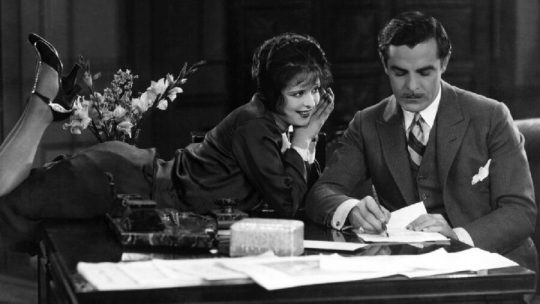
The film, which has been restored by the festival’s organisers and was screened with accompanying music from composer Wayne Barker, now looks remarkably good for its age. The festival’s senior film restorer, Kathy Rose O’Regan, said it was in great shape when they received it. She added: “We imagined it was screened maybe a few times, but there’s hardly any damage – a few scratches here and there, some dirt, but overall in pretty stellar condition.”
Now it has been freshened up and looks its best, but it is still incomplete, being in what Stenn called a “beta version”.
That’s because the copy Huggins found was not from the 1920s, but a 35mm print from the 1950s or 1960s of an edit of the film that was destined to become part of a 16mm compilation of old silent films with a comic voiceover poking fun at its archaic aspects. The intertitles have been removed and there are a few scenes and shots missing, too.
This process is deeply unflattering to old movies, but it has been responsible for preserving versions of silent films that would otherwise have been lost, including the Lois Weber melodrama Shoes from 1916. And the lack of titles are no barrier to following the film.
“For me, it is a pretty perfect 14-minutes of fun,” says O’Regan. “It would be nice to know what the titles were, but you can certainly get the gist without them.”

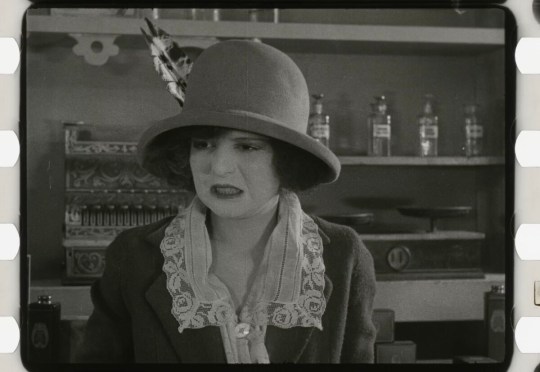
Stenn called the tale of the film’s discovery “miraculous” and led a round of applause for Huggins, who was in the audience. He explained that there was reason to believe that some of the discarded material was among the other cans that were sold at the Omaha auction. The hunt is on to round out The Pill Pounder, and several people have joined in the search, combing through thousands of reels. One Omaha-based film-maker and silent film enthusiast, Alexander Payne, was quick to offer his support.
The film fills in a brief blank period in Bow’s filmography. She shot the role – probably in just a couple of days – in the early “false start” phase of her film career. Bow, a tomboy from a troubled home in Brooklyn, made her debut after winning a magazine talent competition in 1921 but struggled to get her career off the ground.
“I wore myself out goin’ from studio t’studio, from agency t’agency, applyin’ for every possible part,” she later recalled. “But there was always something. I was too young, or too little, or too fat. Usually I was too fat.”
In 1923, she found her way into a handful of films, including The Pill Pounder, where she had the chance to shine in supporting roles, and this is when she finally got her ticket to Hollywood and Paramount.
“She’s not the star of the film, but you can’t take her eyes off her,” says O’Regan. “For the few minutes she’s there she’s divine, she’s fun, she’s full of energy.”
The festival screened The Pill Pounder alongside another new restoration. The feature film Dancing Mothers directed by Herbert Brenon in 1926, is a flapper drama that Bow made for Paramount, in one of her last supporting roles. She plays the reckless daughter of a lonely woman (Alice Joyce) who tires of staying home while her husband and daughter party hard in New York and steps out to go nightclubbing. Bow completely pulls focus from the grownups around her, playing a hedonistic minx, whose body spasms with pleasure when she sips a cocktail.
Stenn described the later film as “like watching a star being born”. Finally, Bow was able to make good on her early promise and start her career as a leading lady. With the breakout comedy It directed by Clarence Badger in 1927, she became a genuine star for the ages. It is easy to look back and assume Bow was destined to become a sensation, but her overnight stardom took a good five years of hard work. The Pill Pounder offers a fascinating glimpse into the route that she took to get there.
By Pamela Hutchinson.
#Clara Bow#The Pill Pounder 1923#Century-Old Clara Bow Silent Film Believed Lost Forever Found#Film-maker Gary Huggins#lost film#silent film#lost and found#flapper#the it girl#american actress#film star#silent film star#silent film era#1920s#1920s style#1920s cinema#1920s hollywood
25 notes
·
View notes
Text





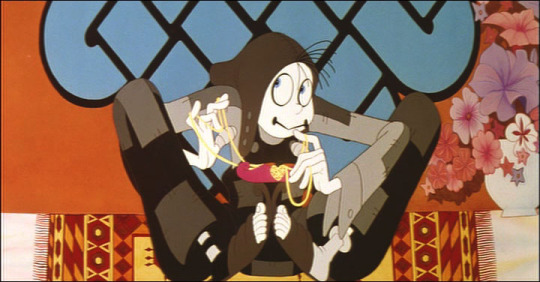




https://youtu.be/FC4sYmilGF8 The Thief and the Cobbler Recobbled Cut Mark 5 Work in Progress 06/20/23
This restoration is still a work in progress. It contains new animation which has not yet been completed, and is "half done" in this preview. At times, there are unfinished edits and smudgy frames.
"Animation among the most glorious and lively ever created!" - The New York Times "The best and most important 'fan edit' ever made." - Twitch Film
Chief Restorationist: Garrett Gilchrist
Directed by Richard Williams Screenplay by Richard Williams and Margaret French Master animator Ken Harris Produced by Imogen Sutton and Richard Williams
Here is your first sneak preview of a newly re-restored version of this lost animation classic, written and directed by legendary three-time Academy Award winning animator Richard Williams (animation director of Who Framed Roger Rabbit, and the author of The Animator's Survival Kit). Nearly 30 years in the making, a labor of love by a team of animation greats, this was to be the masterpiece of Williams’ career, perhaps the most ambitious independent animated film ever conceived. It was taken away from Williams when he couldn’t meet his deadline, recut and destroyed. It has never been seen the way it was intended to be seen … until now. Based on Williams’ original workprint, missing scenes have been restored using storyboards and unfinished animation. Restored to its true form, this lost cult classic has finally been found - for you at home.
2023 could be considered the 60th anniversary of when production began on the film that would become "The Thief and the Cobbler." 2023 is also the 30th anniversary of when production ended on the film, when a reedited version called "The Princess and the Cobbler" had a very small release in some countries. 2023 is also the 10th anniversary of "The Thief and the Cobbler Recobbled Cut Mark 4," a restoration by filmmaker Garrett Gilchrist which intended to restore the film to its original intended form, as much as possible. This is also, approximately, the 25th anniversary of Gilchrist's first experiments with restoring this film.
So we thought it would be a good idea to go back and restore the film further, and see what could be done with it. We still do not have access to a high quality HD copy of any version of the film (such as the released version "Arabian Knight" or Williams' workprint "A Moment In Time"). We do have some 35mm workprint scenes, which we transferred in HD for this project, and which make up over 30 minutes of the film. Some scenes were also upscaled and rebuilt in HD, and all scenes were cleaned up and restored frame by frame by Garrett Gilchrist. Any Blu-Ray labels that would like to take on this project with us officially can contact us.
Garrett Gilchrist writes:
I had often said that I wouldn't do a "Mark 5" edit unless an HD version of the film (in any form) was released and could be used for a better quality version. The "Recobbled Cut" project was begun in 2006 and continued until 2013, originally. That's eight years of work restoring the film (frame by frame in Photoshop!) and building up a huge data archive of Richard Williams' work (Available via ocpmovie at archive. org). I wasn't going to return to the project without a very good reason to do so. No new footage has turned up in our hands in the last ten years.
But it's been ten years since the "Mark 4," and I was approached by animators Dennis Van Hout and Kiko Pablo (The Crow Artist), who had animated a few new shots for the film. It's very difficult, without a budget, to create the sort of high quality animation that this film requires. However, their efforts showed me that it's possible. I had just completed inking a Thief and the Cobbler Coloring Book (available at archive) and felt more confident that I could draw and ink in Richard Williams' style. I chose about twenty shots that seemed possible to animate, and began work on them in early 2023. You can see a half-finished version of the results in this video. I am still working to bring the results up to standard as much as possible.
I also "re-restored" most of the film for this version, rebuilding some shots in HD using cropped DVD sources, recoloring some shots to appear higher quality, removing dirt and damage in Photoshop frame by frame, and doing months of new work to bring the film to life like never before. We were never happy with the HD transfer of the scenes of The Thief in the War Machine, which are very red and dark and lack detail. Some color correction trickery helped bring more detail to the scenes, and dirt and damage was removed by hand in Photoshop over the course of several months.
Other HD scenes were also restored by hand, which had been overlooked for the previous version, because I'd been working on it for eight years at that point and had to stop somewhere. The U-Matic video source for the workprint was also revisited. Pencil test scenes are hard to see due to the low quality of the video source, and I went back to the original source for this version, and cleaned up the scenes very carefully frame by frame to bring out quality and detail that was previously lost. Scenes that previously switched from one source to another have been cleaned up as much as possible so that the sources match seamlessly. Some workprint scenes have been recolored by hand to improve their quality.
The scenes directed by Fred Calvert were done on the cheap and are not up to the quality standards that Richard Williams intended. In this edit I have reworked the Calvert scenes as much as possible, so that they play more smoothly with additional inbetweening. I have removed animation errors and improved scenes with special effects, and rebuild some scenes in HD. This work will continue as time allows.
Our newly animated scenes are also a work in progress, and will require further work to make the animation smoother and more in line with the rest of the film. I am just one illustrator and do not have the budget of a professional animation studio, so I'm really pushing my luck by trying to insert new animation into a cult-favorite masterpiece by one of the greatest animators who ever lived. But I also was careful to choose scenes that are less complex in how they move. It's been a lot of work, and it's still a work in progress. But I hope you enjoy seeing what I've been up to all these months, as well as the delightful new animation by Dennis Van Hout, Kiko Pablo, Chris Fern and others.
#the thief and the cobbler#animation#richard williams#theif and the cobbler#princess and the cobbler#arabian knight#thief and the cobbler#ttatc
169 notes
·
View notes
Photo

C'est fou comme les gens ont de moi cette image de femme sophistiquée, glaciale. C'est une telle erreur, c'est tellement mal me connaître.
- Catherine Deneuve on herself in Belle de Jour (1967)
In anticipation of a new film this summer by Catherine Deneuve called ‘Bernadette’ where she plays Bernadette Chirac, the wife of French Jacques Chirac, I’ve been re-watching some her back catalogue of films. She’s done over 64 films and at almost 80 years old she’s still going strong. And yet out of her many films I’ve always been drawn back to one film which has become a cult classic. Watching it and re-watching it and even gorging on books on its making, new intriguing details reveal themselves about this landmark French art house classic - Belle de Jour (1967).
I once had the privilege of having dinner with her - or rather sat around the same table - through a Parisian host and his lovely wife who had gathered an eclectic group of friends across generations together. I was too self-conscious to talk about her film career directly. I was on surer ground when we indulged in small talk where she was perfectly down to earth and very pleasant. I felt it would be rude to go all fan girl on her and pepper her with questions about Belle de Jour in particular as she’s known to be very ambivalent about her experience of the film - a film that really defined her in the eyes of many people.
But it didn’t mean she didn’t recognise its cultural importance though as she was quite happy to amuse us with a funny story about Belle de Jour. A newly restored 35mm version was funded by the fashion house Saint Laurent back in 2018. Deneuve always had a close relationship with Yves Saint Laurent and also the fashion house. She was the one to introduce Buñuel to Saint Laurent. So the fashion house had a glitzy premiere in New York. But they didn’t count on many of their guests being late. Most of the guests were stuck in the New York traffic and the rain. However Martin Scorsese was the only one to get out of cab and run like a mad man through the pelting rain and huge traffic. A true cinephile, he was so desperate to see the film restored to its former glory that he would go to any lengths to see it.

In Belle de Jour, Catherine Deneuve, whose limpid beauty is capable of sustaining any interpretation, is a perfect Severine and demonstrates a remarkable control in progressing, with enormous economy of gesture and movement, from frigidity to physical warmth as the bored housewife who indulges in part time sex work.
“I felt they showed more of me than they’d said they were going to,” Catherine Deneuve remarked to Pascal Bonitzer in 2004, about the making of Luis Buñuel’s 1967 Belle de jour. “There were moments when I felt totally used. I was very unhappy.”
The story of Séverine, a deeply disenchanted haute bourgeois Paris housewife who finds erotic liberation through byzantine psycho-sexual fantasies and part-time work at an upscale brothel, Belle de jour certainly made extreme demands of Deneuve: her character is flogged, raped, and pelted with muck, among other assaults. But despite her objections to the way she was treated and her difficulties with Buñuel, Deneuve’s performance in Belle de jour turned out to be one of her most iconic.

Deneuve, who had become a star only three years earlier, as the melancholy jeune fille in Jacques Demy’s 1964 all-sung musical The Umbrellas of Cherbourg, was just twenty-three when Belle de jour came out; notably, Buñuel’s film was released in France less than three months after Demy’s radiant, MGM-inspired musical The Young Girls of Rochefort, starring Deneuve and her real-life sister Françoise Dorléac.
But Belle de jour, more than any other film from the first decade of her career, defined what would become one of the actress’s most notorious personae: the exquisite blank slate lost in her own masochistic fantasies and onto whom all sorts of perversions could be projected. (Deneuve as deviant tabula rasa was first seen in Roman Polanski’s 1965 Repulsion, in which she plays a damaged beauty plummeting into psychosis; but Belle de jour doesn’t portray its heroine as mad, instead remaining deliberately ambiguous about the origins of her unconventional desires - and presaging the bizarre libertines she would later play in such films as Marco Ferreri’s Liza, 1972, and Tony Scott’s The Hunger, 1983.)

Buñuel was at a very different stage of his career from his young star, but Belle de jour represented a peak for him as well, the greatest - and most successful - film of his extremely rich late period. These works, bookended by 1964’s Diary of a Chambermaid and 1977’s That Obscure Object of Desire (his final film), were made mostly in France - where Buñuel had begun his filmmaking career with the incendiary, surrealist Un chien andalou (1929) - following the exiled Spanish director’s two decades in Mexico.
Many of these late projects were cowritten with Jean-Claude Carrière and focus intensely on sexual perversion (a theme that recurs throughout Buñuel’s work). Belle de jour certainly falls into that category, and also, typically, skewers the entitled classes. Yet it stands out as the director’s most intricate character study—but of a protagonist who resists definition; the heroine, frequently trussed up and mussed up, retains an odd, opaque dignity in her debauchery.
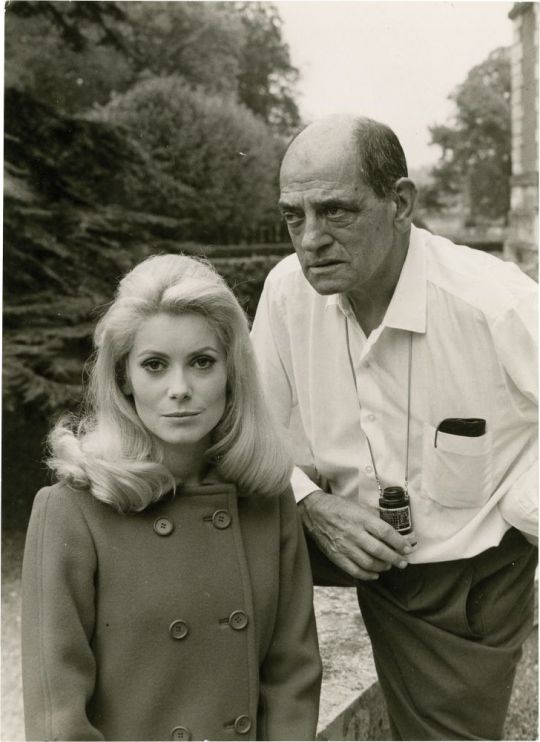
In that same interview with Bonitzer, Deneuve was judicious enough to distinguish her experience of making Belle de jour from the final product, calling it a “wonderful film.” But her first meetings with Buñuel hinted at the duress that was to follow. According to John Baxter’s 1994 biography, Buñuel, it took time for the director to “warm to” his star: “He felt, with some justice, that she had been foisted on him, first by the Hakims [Belle de jour’s producers], then by her lover of the time, François Truffaut.” After dining with Buñuel at his house, the book recounts, Deneuve “left with little more than an impression that he disliked actors in general and was reserving his decision about her. The only advice he offered was the advice he had always given actors: ‘Don’t do anything. And above all, don’t . . . perform.’”
Though Deneuve deferred to her director, she was no puppet; Belle de jour is as much hers as Buñuel’s. The filmmaker, famously resistant to “psychological” interpretations of his work, stuffs Belle de jour with his trademarks, confounding any attempt to parse meaning: the surrealist blurring of fantasy and reality, fetishism, sexual perversion, blasphemy.
But as Séverine, Deneuve, despite operating in the nebulous realm between dream and waking, imbues the film with irresistible and very real lust - and luster. Sporting the chicest Yves Saint Laurent finery, Deneuve revels in the peculiar desires of her character while always inviting our own. As Buñuel himself acknowledges in his 1984 autobiography, My Last Sigh (published a year after his death), Belle de jour “was my biggest commercial success, which I attribute more to the marvelous whores than to my direction.” (Per Baxter, after the filming of Belle de jour, he would finally admit of his star, “She’s really a very good actress.”) Deneuve’s gift was to update the world’s oldest profession for her still-expanding résumé.

The director had some modifying to do as well. Buñuel, who adapted Joseph Kessel’s 1928 novel with Carrière, assessed the source material dryly in My Last Sigh: “The novel is very melodramatic, but well constructed, and it offered me the chance to translate Séverine’s fantasies into pictorial images as well as to draw a serious portrait of a young female bourgeois masochist. I was also able to indulge myself in the faithful description of some interesting sexual perversions.”
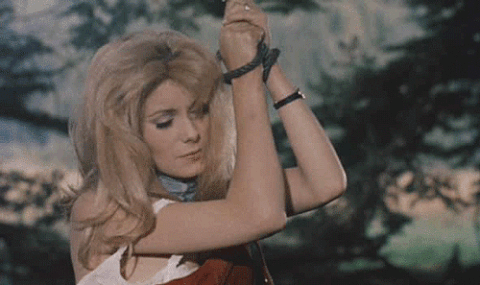
He wastes no time in establishing those bizarre erotic proclivities. In Belle de jour’s opening scene, Séverine and her doting husband of one year, Pierre Serizy (Jean Sorel), a handsome, dutiful surgeon, are snuggled close in a horse-drawn carriage; he interrupts the tender moment with the lament “If only you weren’t so cold.” She pulls away, defensive. The sound of horse bells, which has been increasing in volume from the film’s first shot - and will indicate Séverine’s dreams or fantasies throughout - stops. Pierre orders his wife out of the cab; when she refuses, he and the two drivers remove her by force. She is gagged, bound to a tree, and whipped by the coachmen, who are then instructed by Pierre to rape her. When one begins to ravish her, Séverine appears to be in ecstasy.
This carnal reverie is soon interrupted by the Serizys at home, preparing for their usual chaste bedtime ritual. Pierre, in white pajamas, asks his pale-pink-nightie-clad wife, under the covers in a separate bed, what she’s thinking about: “I was thinking about you . . . and us. We were out for a ride in a carriage”—a scenario Pierre has heard before.

The fantasy clearly belongs to Séverine alone; she finds erotic thrills in her secret thoughts of debasement and humiliation, her florid imagination compensating for her sterile, sexless existence. Her most private desires will soon be realized at 11, cité Jean de Saumur, the address of the boutique bordello run by Madame Anaïs (Geneviève Page), given to Séverine by Pierre’s louche friend Husson (Michel Piccoli).
At Madame Anaïs’s, Séverine - now going by the nom de pute Belle de jour, a reference to her two-to-five shift (she insists on being home when Pierre returns from his workday at the hospital) - is horrified at first but proves to be a quick study. A burly Asian client scares off her two seasoned colleagues with his mysterious, buzzing lacquered box, but she is absolutely transfixed; after the john leaves, she, lying prone on the bed, lifts her head, her luxuriant mane of blonde hair disheveled, to reveal a woman still drunk on orgasmic pleasure.

The contents of the box are one of the film’s many mysteries (when asked what is inside, Buñuel would reply, “Whatever you want there to be”). Yet the greatest enigma is Séverine herself: why does she recoil from the slightest sexual advance from her husband yet lose herself, both in fantasy and in her new line of work, in elaborate masochistic tableaux? “Pierre, it’s your fault too. I can explain everything,” Séverine insists to her husband in the opening fantasy sequence, as she’s being forcibly removed from the landau. But of course, she can’t - and won’t.
As in Repulsion, there are flashbacks to possible childhood trauma in Belle de jour. In one, a man appears to touch a young Séverine inappropriately; in another, she stubbornly refuses the Blessed Sacrament. But unlike in Repulsion, whose final, prolonged shot of a menacing family photo is offered as the root of Carole’s pathology, these scenes in Buñuel’s film are almost non sequiturs, presented not as psychological explanation but as blips in a baroque sexual surrealism.

As Séverine’s reveries and job demands become stranger and more mysterious - in one daydream, she is pelted with thick black mud by Pierre and Husson, who call her “tramp” and “slut”; a ducal client solicits her in the bois de Boulogne to perform in a necrophilic rite - Deneuve retains her porcelain, celestial inscrutability, while simultaneously transforming into an earthbound debauchee, delighting in her own defilement. Madame Anaïs (whose early, shameless flirtation with Séverine - who eventually reciprocates - is the first of the many moments in Deneuve’s filmography that would cement her status as a lesbian icon) touts her new employee’s regal bearing to prospective customers: “[She’s] a little shy, perhaps, but a real aristocrat.”
Séverine’s coworkers, Charlotte (Françoise Fabian) and Mathilde (Maria Latour), are constantly remarking on the impeccable cut and style of her ensembles. Yet what this seemingly untouchable goddess craves most is the brutality of her latest john, the thug Marcel (Pierre Clémenti), a rough with metal teeth, a walking stick that doubles as a shiv, and fetishwear (shiny boots of leather with matching overcoat) that could have been dreamed up in an atelier overseen by Kenneth Anger and Pierre Cardin.
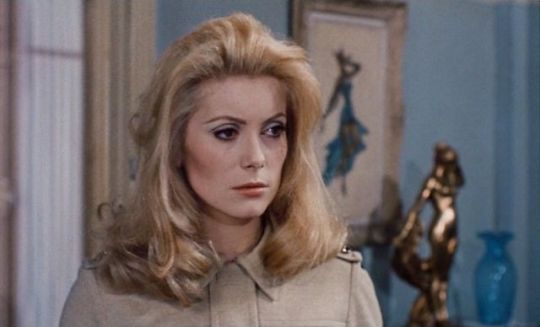
Séverine’s relationship with Marcel will lead to Pierre’s ruin - or does it? The ambiguous ending of Belle de jour suggests that everything that preceded it may have existed only in the heroine’s cracked dreamscape. Like the buzzing box, the film’s final scene is whatever you want it to be.
Yet one thing is certain: Deneuve transcends kink. And despite her misery during the Belle de jour shoot, she would return for even more bizarre treatment three years later in Buñuel’s Tristana, losing both her virtue and a leg.
Almost 55 years after it was made Belle de Jour continues to be a compelling film. It takes on greater curiosity for me as I live in Paris and there are Séverines aplenty that I come across. But the film also speaks to a non-French audience even today as it remains a shrewd commentary on the hypocrisy of social relations and sexual politics. Buñuel invites us to ponder the transgression of a socially respectable woman secretly being a prostitute in the afternoons, but I don’t think he bothered to pose the question why a socially respectable gentleman should be secretly visiting a prostitute in the afternoons - which happens more than one might think and that behaviour is normalised. Something to think about.
#deneuve#catherine deneuve#quote#french#film#movie#cinema#belle de jour#actress#luis bunuel#bunuel#film making#arts#culture#france#scorsese#personal#paris
180 notes
·
View notes
Text
Before and after restored film frame, Star Trek: The Original Series, "Spectre of the Gun"

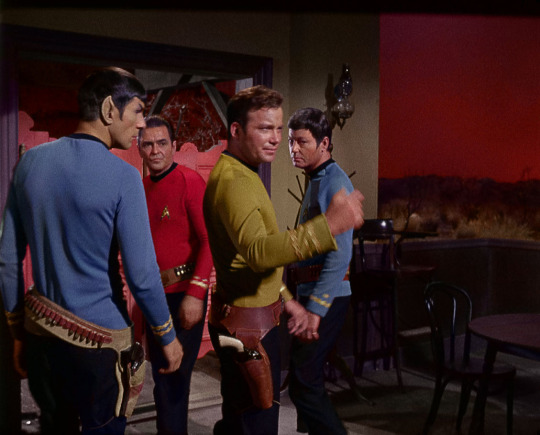

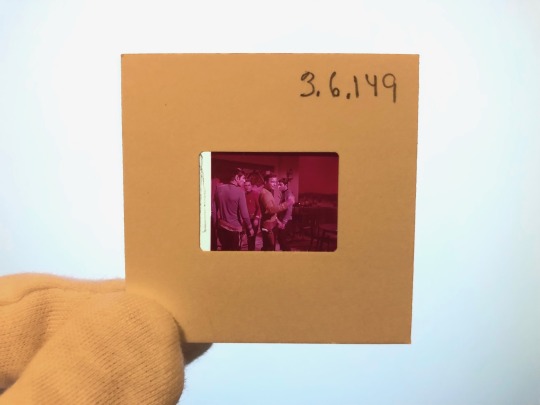
DeForest Kelley breaking the fourth wall.
BTW the expressions in this restored frame from the same episode make more sense after seeing the recently unearthed season 3 blooper reel.
#star trek#star trek the original series#tos#mr spock#jim kirk#leonard mccoy#montgomery scott#leonard nimoy#william shatner#deforest kelley#james doohan#film restoration#35mm film
507 notes
·
View notes
Text

NOIR CITY: Portland
We are delighted to finally be returning to the Hollywood Theatre for NOIR CITY Portland, Friday-Sunday, July 19-21, hosted by FNF prez Eddie Muller. The festival includes screenings of two FNF funded restorations, No abras nunca esa Puerta (Never Open That Door) and The Man Who Cheated Himself as well as the 35mm print we funded of The Window. The restorations were performed by the UCLA Film & Television Archive. The rest of the festival slate comprises Gilda, Night Has A Thousand Eyes, and Eddie’s favorite film noir, In A Lonely Place.

On Saturday, July 20th at 1:00 PM , Eddie takes a break from hosting to converse about his storied career. After the talk, Eddie will be available to sign his books. The Hollywood Theatre will have three of his titles available for purchase - Dark City: The Lost World of Film Noir, Eddie Muller’s Noir Bar: Cocktails Inspired by the World of Film Noir, and for younger, potential noiristas, Kid Noir: Kitty Feral and the Case of the Marshmallow Monkey. This event requires a separate admission for ticket holders.
You can purchase a NOIR CITY: Portland festival pass for just $50 which grants you admission to all the screenings and to the conversation with Eddie Muller.
The festival’s full schedule and tickets to individual screenings are available on the Hollywood Theatre website.
CONFIRMED 2024 NOIR CITY DATES
NOIR CITY: Portland: Jul 19-21 Hollywood Theatre, Portland, OR
NOIR CITY: Chicago: Sep 6-12 Music Box Theatre, Chicago, IL
NOIR CITY: Detroit: Sep 20-22 Redford Theatre, Detroit, MI
NOIR CITY: D.C.: Oct 11-24 AFI Silver Theatre and Cultural Center
NOIR CITY: Philadelphia: Nov 15-17 The Colonial Theatre, Phoenixville, PA
*Other U.S. cities will be added as festival dates are confirmed.
#film noir#eddie muller#noir city#noir city portland#hollywood theatre#noir city film festivals#film noir film festivals#35mm screenings#film restoration#ucla film & tv archive
9 notes
·
View notes
Text
youtube
How did trans people live in the 1960s? Queens at Heart follows four young trans women in NYC as they navigate gender-affirming medicine, work, and relationships. Historian, activist, and filmmaker Jenni Olson stumbled on the documentary’s 35mm reel when it was listed at a projectionist’s sale in the early 90s. The original negative is likely lost forever but the UCLA Film and TV Archive restored the short for the Outfest Legacy Project in 2009.
The film is certainly exploitative and invasive. However, it is still sympathetic and provides a rare look into our history that we otherwise would not have. Watch the full film at https://www.youtube.com/watch?v=X__VKNw0XiI
24 notes
·
View notes
Text

Premiere Restorasi Film Pagar Kawat Berduri
0 notes
Note
First time noir city anon again - it was amazing!! The Reckless Moment and Ace in the Hole both instantly became personal favorites; I love my noir cynical and tragic >:). I dont think I can fully put into words how it felt seeing so many of them in 35mm on a big screen and just appreciating how much would have just been lost without the work of FNF. Such a rewarding experience all around!!!!! (Plus i got Repeat Performance on Blu Ray 😁!)
THE RECKLESS MOMENT HIVE LET'S FUCKING GOOOOOOOOOO
god, i'm so thrilled for you. just absolutely cheesed. i'm sure you heard this over the festival but one of the big goals of this year's noir city is to secure as many 35mm prints as possible so that younger audiences can have the experience of seeing these films on film, and i just love how committed eddie and FNF are to thinking about not just the past but the future of noir and bridging that gap between older, die-hard audiences and the newer generations of noiristas. just absolutely smart programming, you love to see it. i'm so glad you had fun :)
as far as FNF blu-ray purchases go, you cannot go wrong with repeat performance!!! altho all their restorations are great. not a bad film among the bunch.
#asks#FNF does a lot of great year round work and if you consider a donation of like $25 they'll put you on their email list for their quarterly#magazine which rocks! highly recommended - i give to them annually outside of my festival patronage#i am so jelly you got to see reckless moment on a big screen. i hope they bring that one to chicago so i can DIE
9 notes
·
View notes
Text
Movies I enjoyed in 2024 🎬
Thanks for tagging me, @booksandabeer 🍻
Rules: post 9 films you saw for the first time this year and enjoyed, brand new or not but that are new to you, then tag 9 people.




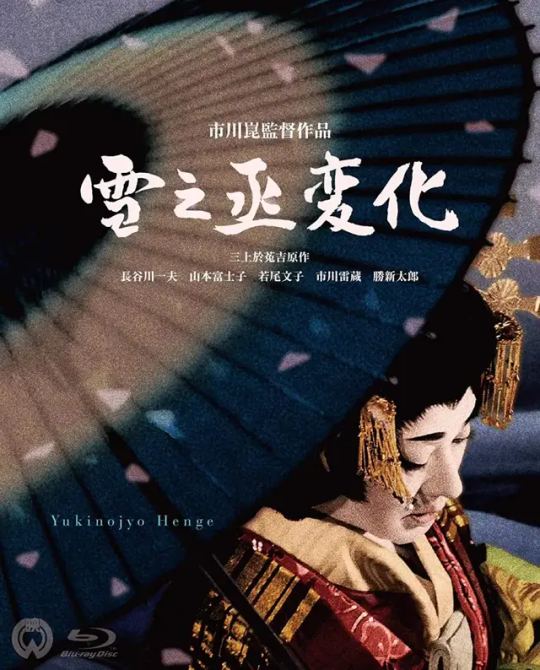




My main criterion for picking these ended up being which films continue to haunt me, such that I think about them regularly—they gnaw at me a little. And I will happily admit that's a funny operational definition of "enjoy." All the same, here are my first-seen-in-2024 picks:
Z (dir. Costa-Gavras)
Funny Ha Ha (dir. Andrew Bujalski)
All That Jazz (dir. Bob Fosse)
Plein Soleil / Purple Noon (dir. René Clément)*
Yukinojō Henge / An Actor's Revenge (dir. Kon Ichikawa)
This Gun For Hire (dir. Frank Tuttle)
Breaking the Waves (dir. Lars von Trier)
Tiny Furniture (dir. Lena Dunham)
Meghe Dhaka Tara / The Cloud-Capped Star (dir. Ritwik Ghatak)
* Seeing Plein Soleil on a gorgeous newly restored 35mm print was one of the highlights of my film-watching year!
This has been going around for a little, so if you'd like to play and haven't, I'm tagging @village-skeptic, @bromcommie, @arctic-turtle-cassiopeia, @theelectricpeach, @moggett, @between-a-ship-and-a-hard-place, @jandjsalmon, @musette22 and @onecontinuoussigh.
(And if you have played and I missed your list, I'd love to see it!)
10 notes
·
View notes